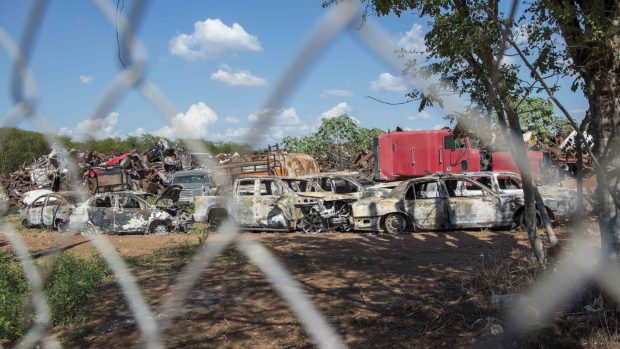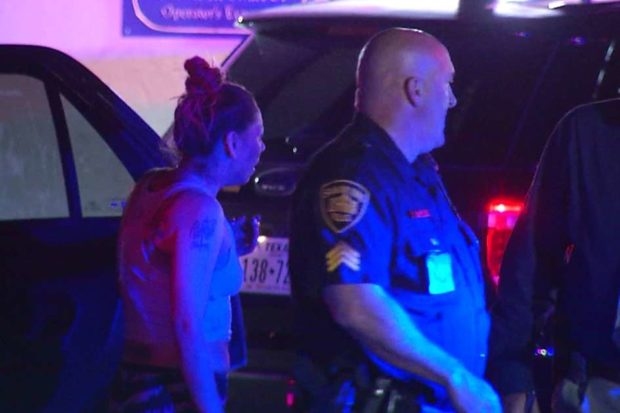‘Graphic Content’ Culiacan Sinaloa Gun-Battle Aftermath
A dozen or so charred vehicles sit in a government impound lot outside this northwestern city including a patrol car, a military pickup, and a tractor-trailer, casualties of a recent terrifying shootout between drug gang henchmen and Mexican security forces.
In a central district where the worst of the violence took place, blown-out windows have been replaced and bullet holes are plastered over on restaurants, convenience stores and a home where the son of Mexico’s notorious drug lord was believed to have been holed up.
https://twitter.com/RAWUNCut5/status/1188109066029223936
Those physical scars of the Oct. 17 gunbattles — what’s come to be known as “Black Thursday” by residents of Culiacan, the capital of Sinaloa and a stronghold of the Sinaloa cartel long led by Joaquín “El Chapo” Guzmán — are beginning to heal. But residents are still coming to grips with the worst cartel violence in recent memory, in which 13 people were killed including at least three innocents caught in the crossfire. More than a week later, it’s what’s on everyone’s lips, from cab conversations to newspaper editorials, as the city of some 800,000 wonders how to move on.
“For people here in Culiacan, there is a psychosis that it could happen again at any moment,” said Marco Castillo, a 52-year-old who works in the transportation industry, speaking on the street-side patio of a restaurant outside of which the gunbattle raged. “On a social level, it is going to leave a scar that will be tarnished by what Culiacan has been through.”
Set in an inland valley between the beaches of the Gulf of California and the marijuana plantations of the Sierra Madre Oriental range, Culiacan is home to major exporters of crops such as tomatoes, chilis, and eggplant to U.S. markets. A low-slung city with few high-rises, its historic center teems with smoky minibusses and families strolling on weekend shopping trips.
Sinaloa has been “El Chapo” territory for about three decades since the cartel was founded, and it’s seen dark times. In 2011, around a high point of Mexico’s drug war, nearly 2,000 people were murdered. But homicides have been on a downward trend more recently with just 695 this year through September, compared with 1,202 for all last year.
So while locals long ago grew accustomed to crime and shootings — mostly between local gangsters — the Oct. 17 firefights were shocking. Hundreds of gunmen with high-caliber weapons blockaded 19 key intersections and river bridges, setting vehicles aflame and turning the cityscape into something resembling a war zone with staccato gunfire and columns of smoke rising skyward.
In the face of the fierce response to their ill-fated operation that had cornered Ovidio Guzmán, federal security officials ordered a retreat and “El Chapo’s” son was free to escape.
But the chaos abated only after residents spent hours hunkering down in homes, malls and auto dealerships as the bullets flew. Outside a car wash where two people died, a smatter of small blood stains can still be seen on the white exterior wall.
Car wash worker Arturo González Verdugo, 18, said he, too, fears it could happen again and that people of Culiacan are resigned to living with violence.
“I think people are already accustomed to … the fact that there are bad people,” González said. “I don’t think it will be forgotten.”
Six 24/7 checkpoints have been set up on the main entrances to the city to search for weapons or contraband. At one, next to a prison where over 50 inmates escaped during the chaos, soldiers and police waved over to the side of the road two young men in a Cooper Mini with tinted windows and out-of-state plates this weekend. They peered inside and made the annoyed passenger step out and unzip a backpack.
Clad head-to-toe in police black, a helmet and a heavy flak vest, an officer who was not authorized to speak to the media in an official capacity said he expects the checkpoints aren’t going away any time soon. Local security officials did not respond to interview requests over the weekend.
There are certainly signs of a return to normalcy. Hundreds of people came out Saturday to dine and listen to live music on a street off the main square that closes to car traffic at night.
Sinaloa Gov. Quirino Ordaz said state tourism and investment have not been harmed by the shootouts, which made international news, and that an effort is underway to burnish the state’s image.
“It is a team effort,” Ordaz was quoted as saying by El Noroeste newspaper. “We are in the streets, many people are going to the plazas, the malls. On the contrary, I think Sinaloans are showing the world their great capacity to move ahead.”
But plenty remains jittery.
A manager of a restaurant on the street where the worst of the gunbattles took place said business has fallen by 60% since. Speaking on the condition of anonymity for safety reasons, the manager said restaurateurs like him need government help to clean up the streets and convince people it’s safe.
“We want to get back up,” the person said. “Recovery is possible.”
Ana Paula Inzunza Mascareño, a 35-year-old psychologist, took visitors from out of town to see the city’s shrine to Jesús Malverde, a Robin Hood-like folk saint revered by many in the narco world. On tables outside, statuettes of Malverde were on sale plus necklaces bearing the images of “El Chapo” and the Holy Infant of Atocha — Ovidio Guzmán had one of the latter around his neck in a mugshot-like picture that surfaced purportedly showing him during the chaos.
Inzunza said she was shopping far from the shootouts when she learned about it.
Family members called each other to make sure everyone was safe and then remained sheltered in their homes.
She’s avoiding going out more than necessary and hopes for peace.
“I think a bit more time has to go by,” Insunza said. “Yes, we have entered normalcy in our jobs, schools and everything, but that uncertainty exists, that little fear … the less we are outside, the better.”
Hundreds of people marched Sunday from a soccer stadium parking lot to a riverside park to call for peace.
“We are here to promote peace, unity,” Mayor Jesús Estrada Ferreiro said.
Billed as a nonpartisan demonstration, there was little in the way of concrete demands.
Rather, many say they just want to go back to a life where the dangers in the city, historically one of the more violent places in Mexico, are a known, manageable quantity.
Related Articles
Guillermo Ibarra Escobar, an urban economist at the Autonomous University of Sinaloa and the author of “Culiacan: City of Fear,” said his research suggests the drug trade and related economic activity represent about 20% of the state’s gross domestic product.
With organized crime inextricably intertwined with society and government over the last 30 years through corruption, collusion, and money-laundering, residents have become used to narcos living in their midst.
“Just as the New Yorker accepts the traffic, just as the inhabitant of Mexico City accepts the smog … the inhabitant of Culiacan knows how to negotiate the day-to-day of ecologies of fear,” Ibarra said.
That was ruptured, he argued, by the ill-conceived raid and ferocious response, and he believes it could be months before a return to the status quo. Culiacan residents seem about evenly divided over whether authorities did the right thing in surrendering to the cartel, and Ibarra predicted they will now be less supportive of future anti-cartel operations after this last one turned the city on its ear.
“There is a kind of routine that lets people calculate how they go about their daily lives,” Ibarra said, “that if they’re going to take their child (to school) in the morning, they won’t run across a group of narcos that are going to be shooting at each other and might get their child killed.”
___
Associated Press writer Andrés Villarreal and video journalist Gerardo Carrillo in Culiacan contributed to this report.
Inquirer.net will receive a commission on purchases made*



